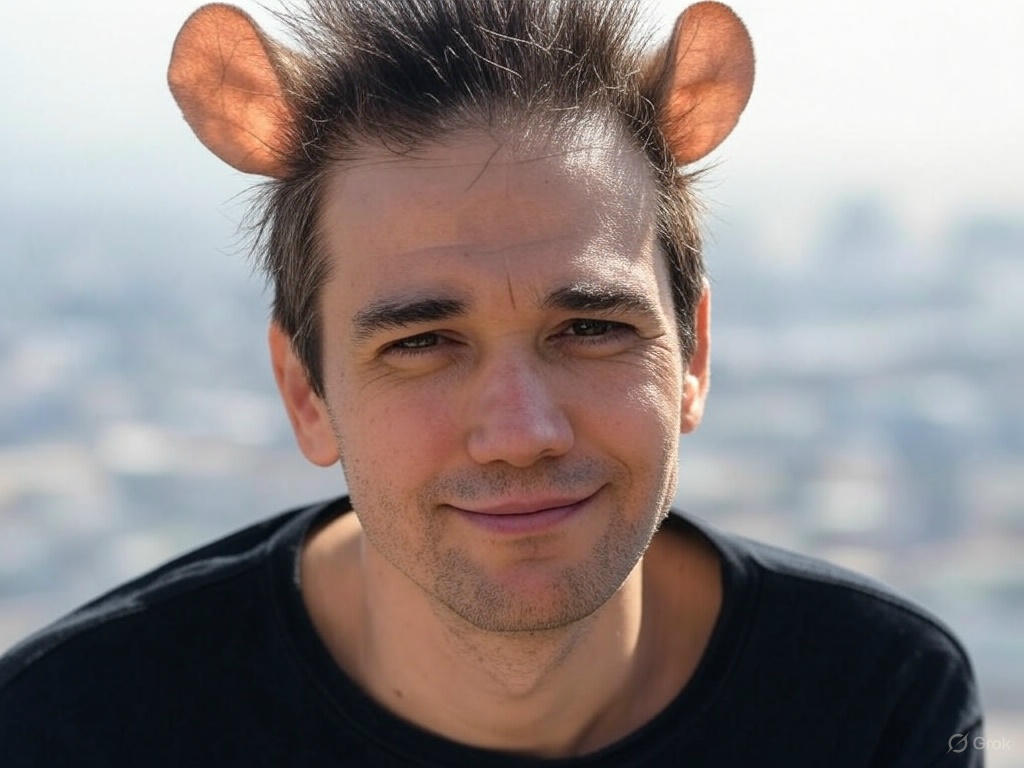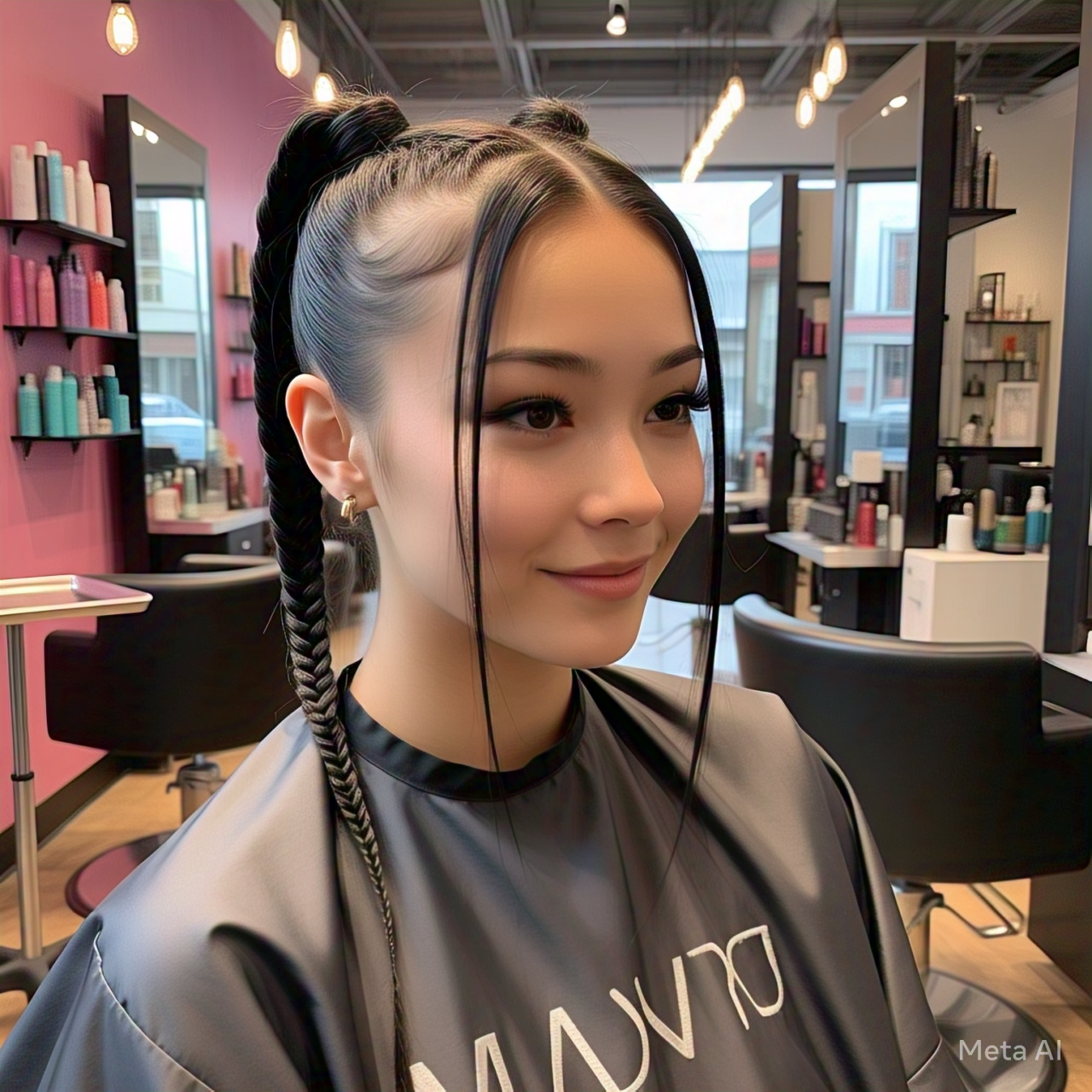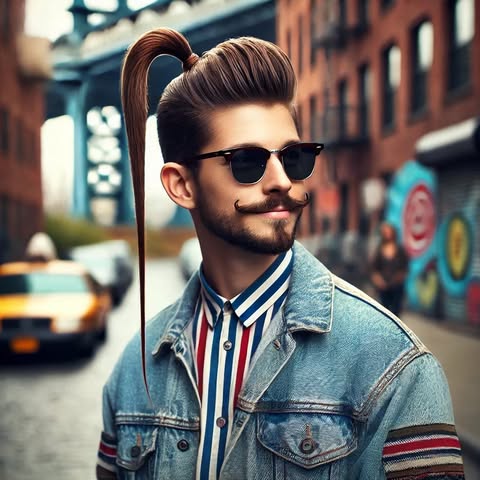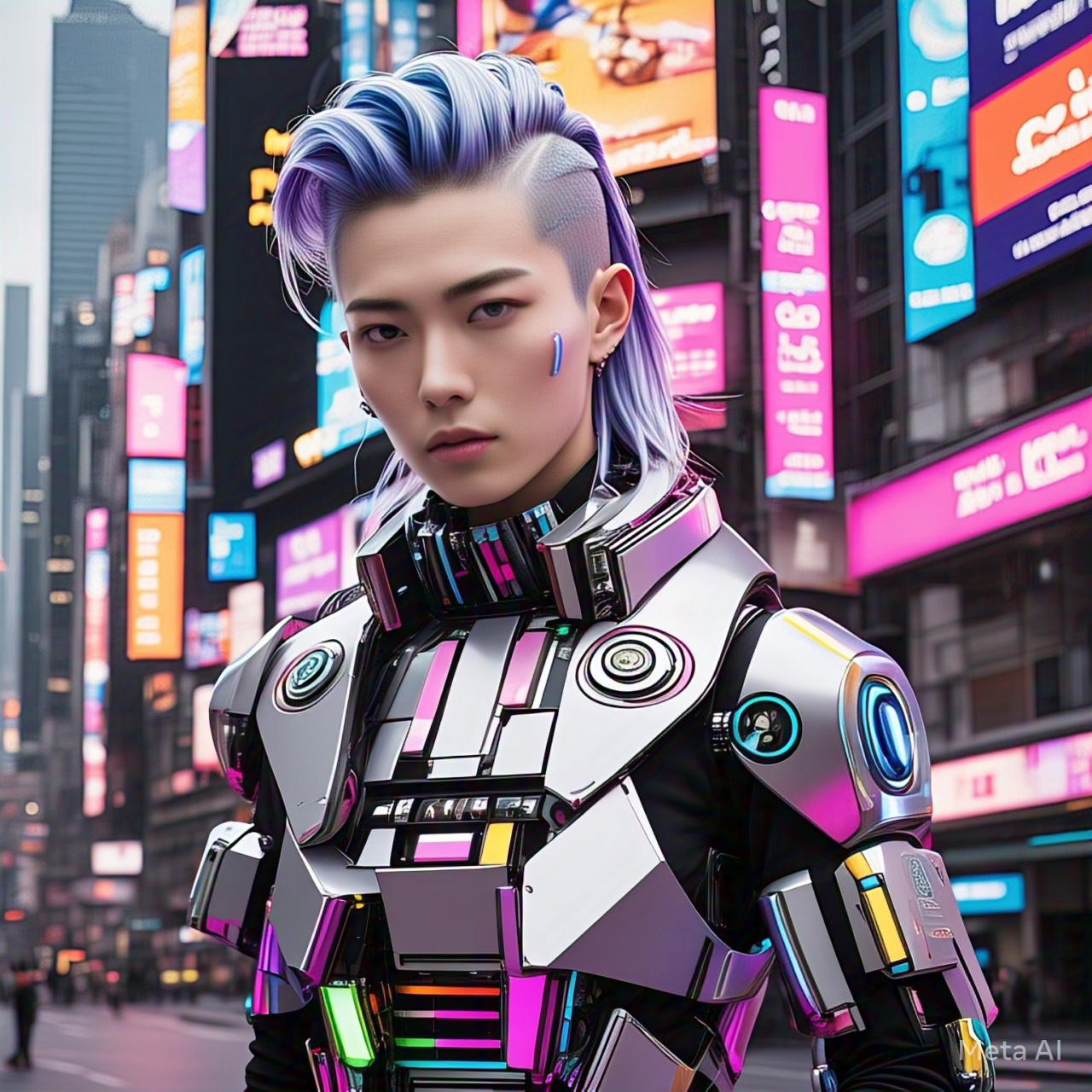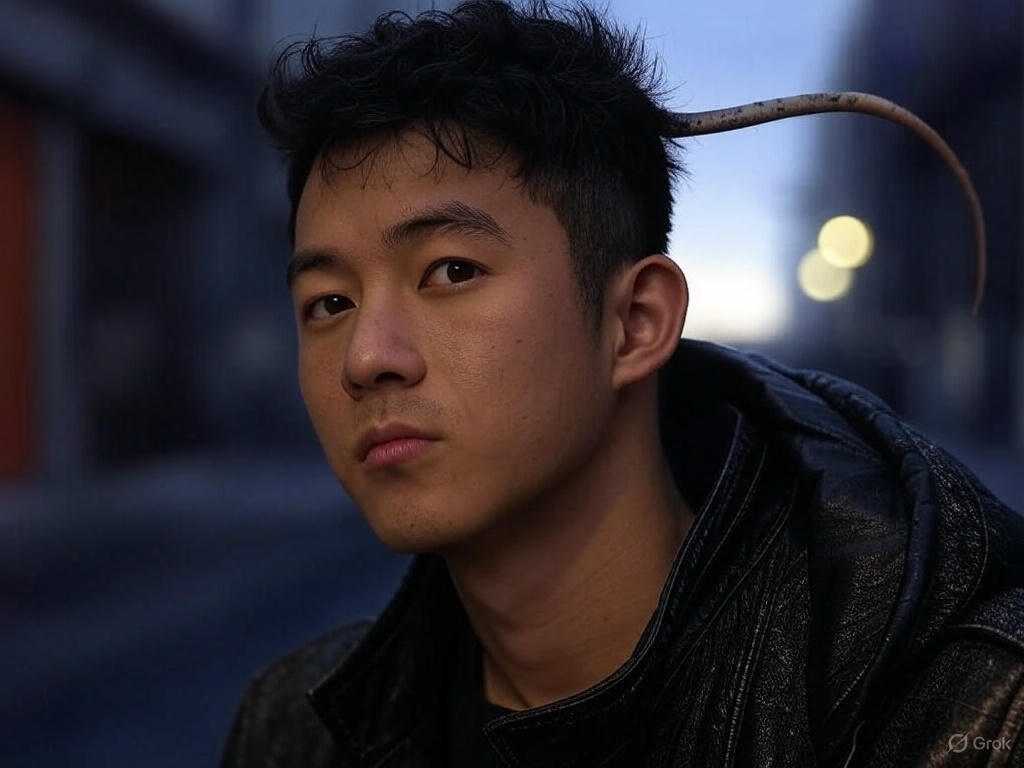A Hairstyle Reborn—The Surprising Comeback of the Rat Tail
The world of fashion and beauty never stands still. What was once considered outdated or even laughable can quickly transform into the next big trend. The rat tail haircut is the latest example of this phenomenon. A style that once dominated playgrounds in the 1980s and early 1990s is now making an unlikely comeback—and celebrities are leading the charge.
The Origins and Evolution of the Rat Tail
The rat tail first gained attention during the late twentieth century. It was a bold and slightly rebellious hairstyle, often associated with individuality and non-conformity. The style is simple but distinctive. The bulk of the hair is cut short, while a small section at the nape of the neck is left to grow long. This thin tail of hair can be braided, dyed, or left to hang naturally. For some, it symbolized freedom and creativity. For others, it was just a fun trend to try.
By the mid-1990s, however, the rat tail fell out of favor. Fashion became more polished, more conventional, and the tail—quirky and non-traditional—did not fit in. Yet the world is now witnessing its return, and the revival is being shaped by some of the most unexpected faces in pop culture.
Celebrity Influence and the Power of the Spotlight
In recent years, celebrities have become more experimental with their looks. From musicians to actors and fashion influencers, public figures are constantly pushing the boundaries of style. This willingness to embrace the unconventional has opened the door for hairstyles like the rat tail to resurface. Instead of being seen as outdated, the style is now celebrated as edgy and cool.
High-profile names such as Shia LaBeouf, FKA twigs, and even certain K-pop idols have been spotted sporting some version of the rat tail. Each adds their own twist—some pair it with undercuts, others color it in bright shades, and some simply let it grow naturally. Their visibility on red carpets, magazine covers, and social media platforms has allowed the style to gain momentum once again.
The Role of Social Media in Trend Revival
Social media has become one of the most powerful tools in driving modern trends. Platforms like Instagram, TikTok, and Pinterest allow users to share and discover styles from around the globe. Influencers and ordinary users alike are able to post their takes on the rat tail, adding creativity and flair that help reinvent the look for a new generation.
What’s interesting is how the rat tail is no longer just a style from the past. It’s being reinterpreted in real time. While the original look might have been simple and even rough around the edges, today’s rat tail can be sleek, styled, and even high fashion. Tutorials on how to grow, trim, and maintain a modern rat tail have begun appearing across beauty platforms, showcasing the renewed interest in this nostalgic trend.
From Irony to Authenticity—Why It Resonates Now
Fashion and beauty trends often work in cycles. A look that seems ironic or humorous at first can slowly gain genuine appreciation. The rat tail fits perfectly into this pattern. Its revival began with a sense of irony—something worn as a joke or a statement—but it’s evolving into something more sincere.
The return of the rat tail speaks to a larger cultural shift. People are more willing to embrace individuality. Instead of following strict beauty standards, many now celebrate the freedom to look however they want. The rat tail, once dismissed as a fashion faux pas, has transformed into a symbol of self-expression.
As it gains more followers and continues to pop up in unexpected places, the rat tail is proving that no trend ever truly dies. It simply waits for the right time, and the right people, to bring it back into the spotlight.
The Cultural Meaning Behind the Rat Tail’s Revival
A Reflection of Rebellion in a Tame World
As modern society grows more polished, digitized, and curated, some individuals are looking for ways to break free from conformity. The reemergence of the rat tail is not just about nostalgia or ironic style—it represents a form of quiet rebellion. At a time when most people rely on algorithm-driven trends and identical aesthetics, something as bold and jarring as a rat tail becomes a statement. It is not just about hair; it’s about resisting uniformity and reclaiming the right to stand out, even if that means drawing curious or judgmental looks.
Celebrities are often the catalysts of this rebellion. When someone in the spotlight chooses to wear something unconventional, it sends a signal. It tells others that there is no single definition of beauty or coolness. Shia LaBeouf’s unapologetic embrace of the rat tail has sparked countless debates online, but that is exactly the point. It creates conversation. It forces people to ask: why should certain styles be off-limits? And more importantly, who gets to decide what’s in or out?
Generational Shifts in Fashion Confidence
Different generations have different relationships with style. Older generations may remember the rat tail as a childhood experiment or a passing phase. For Gen Z and younger Millennials, however, the rat tail is something new, strange, and intriguing. In many ways, it’s like discovering a hidden relic and turning it into a trophy. Young people today are far more likely to experiment with vintage aesthetics and blend them with contemporary sensibilities. What might have been embarrassing in the past is now embraced with pride.
This shift in perception speaks to a greater confidence in personal identity. Instead of chasing approval, many are choosing authenticity. A rat tail might be worn with designer streetwear or with thrifted punk jackets—it doesn’t matter. The style is flexible, and that flexibility gives it strength. People can claim the look for themselves, adding their own spin and rejecting the idea that fashion must follow a specific formula.
Global Fashion Movements and Subcultural Influence
The rat tail is also experiencing an international renaissance, driven in part by the global nature of today’s fashion influences. In parts of Asia, particularly South Korea and Japan, street style has always pushed boundaries. K-pop idols and J-fashion enthusiasts are unafraid to incorporate unusual hairstyles into their looks. When a well-known K-pop idol debuts a sleek, braided rat tail during a performance, the message is clear: uniqueness matters more than tradition.
In Latin American communities, the rat tail never fully disappeared. For many, it was tied to cultural pride or youthful defiance. Now, as Latinx creators gain more visibility on social media, their expressions of beauty are shaping the global conversation. The reappearance of the rat tail in these communities shows how regional trends can grow into global statements.
The Role of Fashion Designers and Stylists
The fashion industry’s elite have taken notice. During recent fashion weeks, several designers included rat-tail-inspired hairstyles in their runway shows. Whether sleek and sculpted or raw and rugged, the tail became an unexpected accent that challenged standard runway beauty. When stylists work with high-profile clients, they often aim to create a signature look—something unforgettable. The rat tail, when executed with purpose, can become a defining element of that signature.
Hairstylists also see opportunity in the return of the rat tail. It invites creativity. A traditional cut might not spark the same conversation or demand the same attention. But a carefully trimmed rat tail—perhaps dyed neon pink, or wrapped in thread—can become a walking piece of art. It gives stylists room to innovate, to play, and to co-create with their clients in new ways.
Nostalgia vs. Reinvention
Some critics argue that reviving the rat tail is merely a case of recycled nostalgia. While that might be partly true, it’s not the whole story. What’s happening now is less about copying the past and more about reimagining it. The modern rat tail is not just a relic pulled from an old photo album. It is being reshaped with precision, meaning, and often a sense of humor.
In the 1980s, a rat tail might have been a spontaneous decision made by a kid in a suburban barbershop. Today, it is more likely to be part of an aesthetic vision—a calculated but playful element of a broader style. This difference is what separates past trends from current ones. The context has changed. The meaning has evolved. And the audience is more aware of the story behind the style.
Style and Self-Expression in a Digital Age
The way people present themselves online affects how trends evolve. On TikTok, short videos can turn an obscure fashion statement into a viral sensation overnight. A well-edited clip of someone flipping their rat tail or braiding it into a unique shape can rack up millions of views. People become curious. They experiment. They share their own interpretations. Suddenly, a look that once seemed laughable becomes aspirational.
Platforms like Instagram encourage carefully curated aesthetics, but they also reward bold choices. Users who dare to break from the crowd often gain loyal followings. A rat tail, unexpected as it may be, signals a willingness to go against the grain. It suggests creativity, individuality, and a sense of humor about fashion. Those are qualities that today’s audiences admire.
Where the Rat Tail Goes From Here
As the rat tail continues to gain attention, its future remains uncertain—but that uncertainty is what makes it exciting. Will it become mainstream? Will it evolve into new shapes and meanings? Or will it fade once again, waiting for another cultural moment to bring it back?
What is clear is that the rat tail has transcended its original definition. No longer just a childhood phase or a comedic reference, it has become a symbol. It represents the freedom to express, to experiment, and to own one’s style without apology. That kind of freedom is rare—and always in fashion.
The Modern Rat Tail Is Here to Stay—For Now
Whether worn by celebrities on the red carpet or teens in their school hallways, the rat tail is making its presence known. It might still provoke strong opinions, but it also invites admiration. In a world that often encourages people to blend in, those who choose to stand out—no matter how small the detail—create waves that ripple far beyond fashion.
Styling the Rat Tail—Modern Interpretations and How It’s Worn Today
The Rat Tail Enters a New Era of Hair Design
Trends often return in forms that are far removed from their original expressions. The same is true for the rat tail. What was once a loose strip of hair hanging behind a clean-cut head has evolved into a canvas for artistic experimentation. In today’s fashion-forward world, the rat tail has become more than just a nostalgic throwback. It is now a feature of high-concept grooming, used to challenge the norms of what is considered attractive or stylish.
Rather than copying old versions, many are choosing to customize their rat tail to reflect personal style, cultural background, or creative expression. Some opt for a minimalist design with a slim, natural tail that blends subtly with the rest of their haircut. Others take the bold route, incorporating bright colors, beads, braids, or even sculpted ends that loop or curl. This range of expressions shows just how flexible the rat tail can be when it’s not confined by the limits of past trends.
Blending the Old with the New
Contemporary hairstyling allows for greater blending of multiple trends. That’s why the rat tail now often appears alongside undercuts, fades, mohawks, mullets, and buzz cuts. The contrast between the short sides and the single extended tail adds a surprising visual element that challenges symmetry and breaks convention.
In urban fashion circles, some stylists refer to it as “rat tail remixing.” This creative practice combines elements from punk culture, traditional grooming, and modern barbering techniques. The result is a hybrid look that feels fresh, strange, and exciting. These new rat tails are not afterthoughts; they are carefully shaped and styled with intention. Edges are lined up. The tail may be trimmed with sharp precision. Even the length can be calculated to align with accessories or clothing choices, turning the style into a full aesthetic statement.
Gender Fluidity and Hair Freedom
One reason the rat tail is thriving today is that hair is no longer strictly categorized by gender. Fashion is increasingly fluid, and hairstyles are seen as tools for exploring identity, not just projecting masculinity or femininity. The rat tail fits perfectly into this evolving view. On one end, it can appear masculine when paired with rugged cuts and facial hair. On the other, it can be elegant, playful, or androgynous, depending on how it’s styled and presented.
Public figures who identify outside of the binary have embraced the rat tail as a way to highlight that freedom. Some have made it part of their signature look, blending it with outfits that also challenge traditional roles. The versatility of the rat tail lies in its ambiguity—it’s not clearly one thing or another. That ambiguity allows it to serve as a neutral ground for creativity and identity exploration.
Influence of Subcultures and Street Style
While celebrities help bring visibility to trends, it’s often underground scenes that breathe life into them. Streetwear communities, skate culture, rave scenes, and DIY punk circles have all had a hand in shaping how the rat tail is currently perceived. Within these subcultures, the rat tail is not just about fashion. It is a symbol of defiance, a nod to the past, and a way to connect with a larger group of rule-breakers.
In these groups, the rat tail is rarely polished. It is often left raw, frizzy, or uneven—intentionally imperfect. That imperfection becomes a badge of honor. It communicates a refusal to conform to the glossy, high-production beauty standards of mainstream culture. And yet, despite its unrefined aesthetic, it gains admiration for being bold and real.
Hairstyling Techniques and Maintenance
While the rat tail may seem simple, maintaining it requires care and attention. Barbers and stylists have developed techniques to shape the tail cleanly while keeping the surrounding hair balanced. For a more sophisticated version, layering and tapering may be used. Some choose to add texture or body to the tail using curling tools or light styling products. Others prefer a sleek look, smoothing the hair with oil or pomade.
Coloring has also become a major part of rat tail customization. Some dye the tail a contrasting color from the rest of the head, creating an instant focal point. Others go for patterns—split dyes, stripes, or even glow-in-the-dark effects for nighttime impact. These enhancements turn the rat tail into more than a haircut; they make it part of an evolving visual identity.
Hair accessories are also part of the story. Small beads, metal clips, or string wraps around the tail can introduce a cultural or personal flair. These adornments are often chosen to match earrings, chains, or clothing, which ties the entire look together in a cohesive way. Maintaining these styles requires regular trimming, conditioning, and occasionally re-dyeing, especially if the tail is a bright or unnatural color.
The Role of Fashion Photography and Editorial Styling
Editorial stylists have also embraced the rat tail as a statement piece. In high-fashion photography, the rat tail has been used to add an edge to otherwise clean, avant-garde looks. It breaks the smooth lines of formalwear, adds a sense of surprise to a high-gloss image, or contrasts with delicate makeup in artistic shoots.
Fashion magazines now use the rat tail not just as a quirky detail but as a focal point. Editorials might highlight a single braid hanging against an open back or feature a platinum blonde tail set against jet-black hair. These images help recast the rat tail from a juvenile prank into a curated style choice.
The Rat Tail in Pop Culture Narratives
The appearance of the rat tail in television and film has further fueled its return. In recent years, characters in drama series, indie films, and even fantasy franchises have been shown sporting some version of the rat tail. These characters are often meant to stand out, to appear rebellious, mysterious, or emotionally complex.
In this context, the rat tail becomes more than style—it becomes storytelling. It says something about who that character is and how they navigate the world. For viewers, especially younger audiences, these visual cues can be powerful. They create associations between uniqueness and strength, between being different and being desirable.
The Social Media Pipeline: From Joke to Trend
The process by which the rat tail becomes trendy again often begins with humor. A user on TikTok posts a video of themselves growing a rat tail as a joke. The clip goes viral. Another user replies with their own exaggerated version. Eventually, someone posts a genuinely stylish take on the same concept. Before long, what started as parody becomes fashion.
This evolution is part of the social media pipeline that fuels most modern trends. What’s different with the rat tail is that its transition from joke to genuine style happens quickly. That speed is a testament to how open-minded and curious today’s audience is. They are ready to try something new, even if it makes them stand out—maybe especially if it makes them stand out.
The Balance Between Fashion and Function
The rat tail also invites conversation about the balance between fashion and function. Unlike other hairstyles that require constant upkeep, the rat tail can be fairly low-maintenance once the tail reaches the desired length. This makes it accessible to people who want a bold look without daily styling.
At the same time, its dramatic effect depends on deliberate contrast. That means the rest of the haircut must be managed with care. A rat tail can’t hide behind casual neglect—it needs framing. This balance of boldness and subtlety is what makes it such a dynamic choice in a world of flat trends.
The Psychology Behind the Rat Tail and What It Says About Identity
Hair as a Personal Statement of Rebellion
For generations, hair has been used as a statement of self. Whether through style, color, or length, people have used their hair to broadcast identity, defy social norms, or embrace cultural roots. In that context, the rat tail emerges not just as a revived trend but as a psychological symbol of resistance, individuality, and even transformation. To understand why celebrities and everyday individuals are embracing the rat tail again, it’s important to explore the deeper emotional forces at work.
The rat tail doesn’t conform to mainstream standards of beauty. It’s not symmetrical, polished, or traditional. That makes it ideal for people who are tired of blending in or being boxed into certain categories. It becomes a deliberate challenge to expectations. By keeping one strand of hair long while the rest is trimmed short, the wearer makes a decision to stand apart, even at the risk of ridicule. That boldness reflects a deeper need to express power and ownership over appearance, especially in a world where image is often controlled by trends, filters, and media norms.
Reclaiming a Style Once Used for Ridicule
For many, especially those who remember the rat tail as a source of teasing or embarrassment, bringing it back is also a form of healing. What was once laughed at can now be worn with pride. This act of reclaiming something once considered “ugly” or “awkward” is psychologically powerful. It reflects a larger shift happening across fashion and beauty where flaws are embraced, weirdness is celebrated, and uniqueness becomes currency.
The new rat tail represents the idea that nothing is ever permanently out of style—it’s all about how confidently it’s worn. This mindset is reshaping the way people approach self-image. Rather than asking “Is this attractive to others?” they are asking, “Does this feel like me?” The rat tail becomes a mirror, not of current popularity, but of personal courage and authenticity.
The Role of Nostalgia in Style Resurgence
Much of the rat tail’s comeback is fueled by nostalgia. Pop culture cycles through decades, and the early 2000s and late 90s are currently having a strong influence on what people wear, listen to, and post online. For millennials and Gen Z, the rat tail brings back memories—some ironic, some sincere. Whether it reminds someone of a sibling, a celebrity, or a version of themselves from childhood, the style is emotionally loaded.
Nostalgia softens the edge of the rat tail’s unconventional look. It gives people permission to experiment with it not just for fashion, but for fun. Wearing one can be an inside joke, a nod to a time when life felt simpler or more playful. And in an age when people are constantly navigating change and instability, leaning into something familiar—even if it’s a hairstyle—can be deeply comforting.
The Influence of Cultural Identity
In some communities, the rat tail or similar styles have never gone out of fashion. In Polynesian cultures, for example, long braids or single strands carry meaning tied to tradition, ancestry, and spirituality. In Latino communities, variations of the rat tail have remained present in specific neighborhoods or among younger generations raised by parents who once wore the look themselves. These connections root the style in something larger than trend—it becomes a marker of cultural memory.
For individuals from these backgrounds, the rat tail may not feel ironic or new at all. It’s part of a legacy that they now wear with pride. As mainstream fashion begins to incorporate more global influences, these deeply rooted styles are receiving renewed respect and attention. What was once overlooked or mocked is now being appreciated as part of a larger, diverse narrative.
Celebrity Power and the Influence of Public Image
When celebrities bring back a controversial or outdated style, they do more than simply wear it—they redefine it. This is particularly true for the rat tail. A-list figures like musicians, athletes, or actors often exist in a space where risk is rewarded. They can try something that most would avoid and instantly make it appealing.
The celebrity effect gives the rat tail a level of social approval it hasn’t had in decades. When someone like a pop star shows up at a fashion event with a sculpted, styled rat tail, it changes the cultural conversation. It tells the public: “This isn’t just weird—it’s cool again.” That type of influence can’t be underestimated. It creates a ripple effect, where fans, followers, and aspiring style icons all begin to try it out in their own way.
Fashion is no longer top-down, however. While celebrities start the conversation, it’s social media users who carry it forward. The rat tail’s rise has been amplified by everyday people posting their own versions online—styled with care, humor, or bold confidence. This decentralized flow of influence makes the trend more relatable and less intimidating.
Hair and the Evolution of Self
Wearing a rat tail can represent more than style—it can reflect a person’s evolution. Hair grows and changes with us. A style like the rat tail takes time to form, and during that time, the wearer may go through personal shifts, milestones, or transformations. By the time the rat tail reaches full length, it often symbolizes endurance, commitment, or change.
Some people even document their hair journey as a reflection of emotional growth. They associate each inch of the rat tail with a new phase—whether it’s recovering from hardship, embracing identity, or moving into a more confident chapter of life. In this sense, hair becomes a timeline, and the rat tail becomes a small but visible part of a larger personal narrative.
The Dare Factor—Why Some People Say Yes
Not everyone will wear a rat tail, but the question itself—“Would you dare?”—is revealing. Fashion has always contained an element of challenge. People want to be surprised, impressed, or slightly unsettled by what others are wearing. The rat tail offers exactly that. It creates tension. It sparks debate. And it forces people to look twice.
For some, that dare is too exciting to ignore. Wearing a rat tail becomes a test of confidence. It asks the individual to hold their ground, even if others don’t understand. And once that hurdle is cleared, it often leads to a greater sense of freedom. Hair no longer has to be perfect—it just has to be real.
Public Reactions and Personal Resilience
One of the challenges with daring styles is how people respond. The rat tail draws attention, and not all of it is positive. Some may laugh. Others may stare. But the people who wear it successfully don’t just have a strong sense of fashion—they have resilience. They can handle critique because they’re not trying to please everyone. That independence is often more attractive than any style itself.
In fact, many people report that wearing a rat tail leads to unexpected compliments. What begins as an experiment sometimes becomes a signature. It sparks conversation, invites curiosity, and, in some cases, inspires others to try something equally bold. The cycle continues as confidence builds, and a style once feared becomes something to celebrate.
A Closing Look at a Bold Revival
The rat tail is more than a nostalgic nod to past decades. It’s a living example of how fashion evolves, adapts, and redefines itself over time. From red carpets to city streets, from viral videos to intimate identity journeys, the rat tail has returned not just to make a statement, but to challenge what a statement even is.
It symbolizes individuality in a world that too often encourages uniformity. It stands for cultural memory in an industry obsessed with novelty. And above all, it shows that daring to be different—especially when the world tells you not to—is always in style.


